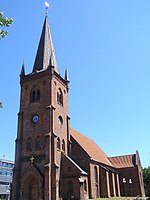Vejle River

Vejle River (Danish: Vejle Å, also called Sønderåen, "South River") is an approximately 32-kilometre-long (20 mi) river in Vejle Municipality in Denmark. Its source is Engelsholm Lake near the village of Nørup. It first runs south to converge with the Egtved River near the village of Egtved, then flows northeast for 20 kilometres (12 mi) through the Vejle River Valley (Danish: Vejle Ådal) until it reaches the city of Vejle. There, the river meets the Grejs River and then empties into Vejle Fjord. Vejle River Valley and Vejle Fjord together form the longest tunnel valley in eastern Jutland. The lower river has an urban character where it runs through downtown Vejle, while the upper river is rural and is used for fishing and recreation.
Excerpt from the Wikipedia article Vejle River (License: CC BY-SA 3.0, Authors, Images).Vejle River
Kvasen, Vejle
Geographical coordinates (GPS) Address Nearby Places Show on map
Geographical coordinates (GPS)
| Latitude | Longitude |
|---|---|
| N 55.7012 ° | E 9.557 ° |
Address
Kvasen
7100 Vejle
Region of Southern Denmark, Denmark
Open on Google Maps











